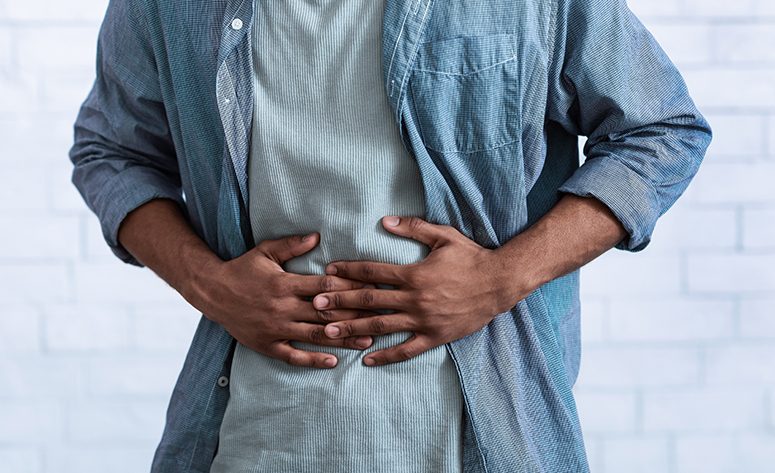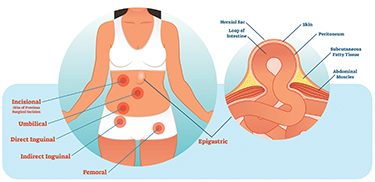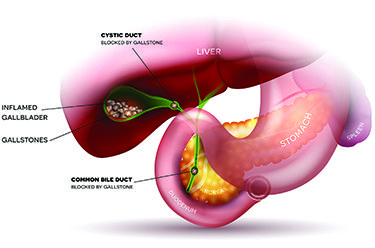Abdominal Wall Hernia,
Cholelithiasis (GALLSTONES)

Abdominal Wall Hernia
Abdominal wall hernias are among the most common problems that may require a surgical solution. An estimated 10 percent of the population may suffer from a hernia in their lifetime, and the FDA reports that more than 1 million people in the United States have hernia repairs each year.
A hernia is a protrusion of part of an internal organ from the cavity where it normally resides through a preexisting or acquired defect in the wall. Most common abdominal wall hernias are external and may be visible as a permanent or periodic bump in groins (inguinal and femoral hernia), around the navel (umbilical hernia) and along the middle line of the belly (ventricular hernia). Internal abdominal hernias are protrusions of abdominal organs into another internal space. The most known is a hiatal hernia, which is a protrusion of the stomach (gaster) through the diaphragm into a chest cavity.
The most common abdominal wall hernia is an inguinal hernia, which is a protrusion of the intestines through the abdominal wall in the groins and sometimes into the scrotum. Inguinal hernias may be indirect and occur due to an incomplete closure of a passage through which the testicles descend from the abdomen into the scrotum. The condition usually occurs early in life but may manifest at any time. The FDA reports that about 800,000 surgical inguinal hernia repairs occur in the United States each year.44
Adult males more often have a direct inguinal hernia, which happens due to a weakening of the muscular wall. The incidence increases in males over age 40 and may affect 25 percent of males and 2 percent of females.45 Risk factors are being male, lifting heavy objects and straining such as with chronic coughing or overcoming constipation.
Most inguinal hernias appear as a painless swelling or bulge in the groin that may occur gradually or suddenly after heavy lifting. In the beginning it may be reversible when the affected person reclines, or it may be reduced with light manual pressure. With time, however, it becomes larger and does not reduce easily. The occurrence of pain and tenderness requires urgent evaluation.
When the hernia cannot be reduced at all, it is incarcerated (trapped) and requires surgical repair. If the intestines in the hernia get twisted, a painful emergency condition called strangulation occurs. The blood flow to the intestine gets interrupted, and the affected part of the intestine will die due to lack of oxygen if not corrected within hours. The patient will develop inflammation and infection, which can be fatal if not treated.
Cholelithiasis
Cholelithiasis is a chronic condition characterized by a presence of gallstones in the biliary ducts and gallbladder. Gallstones may cause obstruction of the biliary system and prevent excretion of bile into duodenum. Pressure will increase and cause pain, which can be episodic and transitory. The condition may worsen and result in prolonged, acute painful episodes. Cirrhosis, diabetes, hemolysis and Crohn’s disease have been associated with gallstones.
The gallbladder may generate pain and cramping to the right upper quadrant just below the right rib cage and can radiate to the right shoulder and scapula. It is classically seen in obese females and people older than 40, but it also occurs in a much wider range of the general population. Gallstones occur in more than 5 percent of asymptomatic people.
The characteristic right upper-quadrant pain radiating to the back is often associated with a fatty meal, but this pain can occur at other times, often at night, and is usually unaffected by position, bowel movement or flatus. Nausea and vomiting may also occur. Imaging often confirms the diagnosis.
Should the gallbladder become infected, accompanied by increased pain, fever and chills, seek prompt medical attention as these worsening symptoms can be cholecystitis. Palpation just under the right rib cage with a deep inspiration may elicit sharp pain, which is due to inflammation caused by infection. Simple cholelithasis seldom illicits such pain with palpation.
If cholelithiasis is suspected, the pain can be managed with analgesics. Avoid fatty foods during this period as the symptoms may recur or worsen.
If cholecystitis is suspected when the pain is accompanied by generalized symptoms that include fever and chills, seek prompt medical care. Medical attention should include an IV to enable hydration and possible antibiotic administration if possible.
Avoid foods that cause or exacerbate symptoms. Obesity and a sedentary lifestyle as well as rapid weight loss may increase risk. Consumption of coffee, vitamin C, polyunsaturated fat and nuts has been linked to the prevention of gallstones.

TYPES OF HERNIAS
A hernia is a protrusion of part of an internal organ from the cavity where it normally resides

GALLSTONES
Cholelithiasis is a chronic condition characterized by a presence of gallstones in the biliary ducts and gallbladder.
DAN Customer Service
Mon–Fri, 8:30 a.m. – 5 p.m. ET
+1 (919) 684-2948
+1 (800) 446-2671
Fax: +1 (919) 490-6630
24/7 Emergency Hotline
In event of a dive accident or injury, call local EMS first, then call DAN.
24/7 Emergency Hotline:
+1 (919) 684-9111
(Collect calls accepted)
DAN must arrange transportation for covered emergency medical evacuation fees to be paid.
Medical Information Line
Get answers to your nonemergency health and diving questions.
Mon–Fri, 8:30 a.m. – 5 p.m. ET
+1 (919) 684-2948, Option 4
Online: Ask A Medic
(Allow 24-48 hours for a response.)